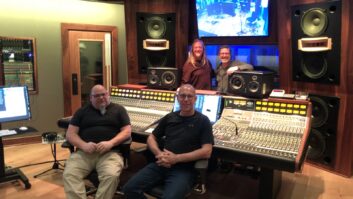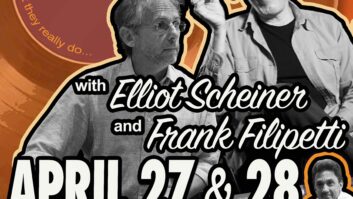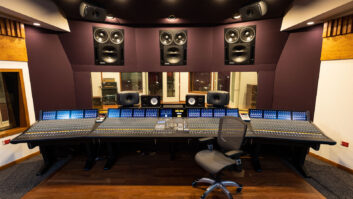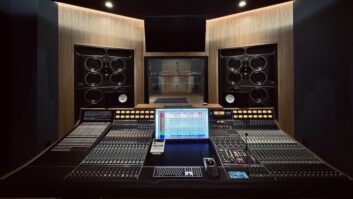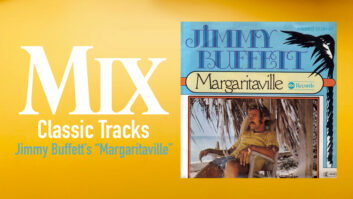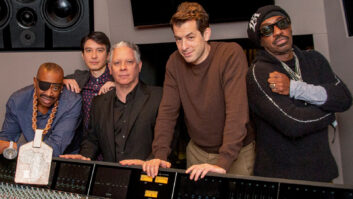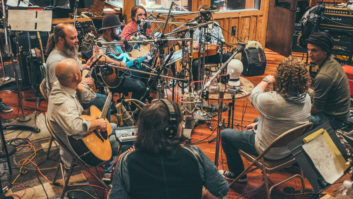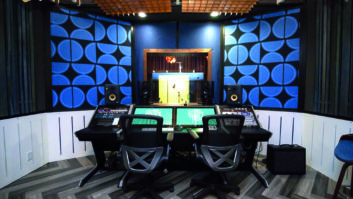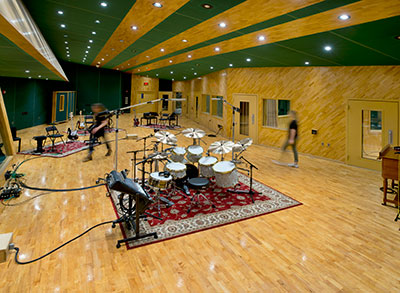
Just off of Nashville’s famed Music Row, Music Circle South doglegs and then ends at a cul-de-sac in front of The Tracking Room, a single-purpose facility that is Nashville’s largest recording studio. “There’s something about this room that is really unique,” says David Haskell, president of the Morris family of entertainment enterprises, The Tracking Room’s parent organization. “People who work here regularly know it already. The ones that don’t feel it as soon as they walk in. This is what a properly engineered room is supposed to sound like.”
In January of last year, implementation began on a deliberate and calculated plan to restore The Tracking Room to peak performance, to ensure unsurpassed client support and satisfaction, to provide the technology to enable creativity. A substantial investment was made in modernizing hardware and software and in giving the facility aesthetics a facelift, its first major overhaul since opening in the mid-1990s.
Room to Breathe
Space is the missing ingredient in nearly every personal production studio: Space for musicians to comfortably play together and interact while still isolating instruments effectively. Space for an orchestra. Space for instruments and artists to breathe. The Tracking Room measures 70 feet long by a varied 25 to 45 feet wide, with 20- to 25-foot ceilings. Sound absorption is hidden behind the grille cloth walls and in the ceiling. The building sits on Tennessee limestone, with an interstate just beyond and 20 feet below the foundation; inside The Tracking Room, with its floating floors and room-within-a-room construction, you’d never know. The quiet demands attention when the room’s not in session.

The Stone Room iso booth
The 100 feet of space along the studio’s rear wall is divided into five generous isolation rooms. Iso 1, the Stone Room, has a slate floor and rock walls with a sloped hard-plaster ceiling. It is highly reverberant yet can be tamed—an intriguing space for experimentation. Iso 2, with a walk-in amp locker designed to produce a natural acoustic compression, is for electric guitars. Isos 3 and 4 are remarkably spacious, with one wood wall, soft front and side walls, and trapped rear walls. Dense curtains can be used to dampen the wood. Iso 5 is the Piano Room, with all hardwood walls (two with curtains for damping) and a hardwood ceiling. A popular Yamaha C7 is the featured instrument, with the room imparting a natural and piano-flattering tone. Side windows let musicians see from Iso 1 through to Iso 5; front windows look onto the main studio floor.
The spacious control room, with its volume continuing above ceiling and into the side and rear walls, was designed to allow a 20 Hz wave to develop. The main monitors are the 20Hz version of the Kinoshita/Hidley cabinets (in stunning piano black), with a horizontal center-channel version to support surround applications.
The control room floats on nine German-engineered springs. The air-handling throughout the facility is quiet, with large insulated flex ducting snaking through the ceiling above the iso caps, avoiding direct paths between spaces and the outside world. The list of fine details in the Hidley design and the studio’s construction goes on extensively.
There are many impressive somethings about The Tracking Room. Space, flexible lighting, warm wood tones and fabric accents catch the eye immediately when entering the main studio floor. The blend of hard and soft surfaces, with carefully planned angles, gives the enormous space a subtle character. With all the available spaces, and the spaces within those spaces, the permutations for a broad palette of sonic signatures are legion. And in the finest tradition of service-oriented studio staffing, the people truly do make The Tracking Room special.
But true understanding of what makes the space unique comes from working there.

The Piano Room iso booth
The Client View
Justin Cortelyou is a Nashville-based recording engineer and mixer with credits ranging from Paul McCartney to Phish, from Taylor Swift to Alice Cooper. His first Tracking Room experience was with frequent collaborator and mega-producer Bob Ezrin, working on tracks for Deep Purple’s 2013 release, Now What? Cortelyou’s most recent dates at The Tracking Room were for Deep Purple’s follow-up. While having positive experiences prior to the renovations, Cortelyou says there was a “night and day difference.”
The replacement of the very-early SSL 9000J (one of the first built) with the 80-channel 9000J from Quad Studios Nashville, was one major difference. The already impressive complement of outboard gear was enhanced with kit including 16 channels of Millennia Media HV-3D preamps (given kudos by Cortelyou), an Empirical Labs Fatso Jr. and a pair of Kush Audio Clariphonic EQs. The house Pro Tools HDX system now supports 90 channels of I/O and boasts a plethora of plug-ins. A producer’s desk was added in the back of the spacious control room.
Cortelyou was quick to compliment the previous staff, while praising current studio manager Matt Leigh, calling him “just fantastic…the little things definitely do not go unnoticed.” Additional praise went to staff engineer Bryce Roberts. “Bryce is just terrific,” Cortelyou says, singling out his notetaking and documentation. “He was so engaged in the session. You cannot have technical problems. If you have to change a mic placement or swap out a snare drum, that change has to be made as quickly as possible so we don’t kill the flow of the session. Before Bob would even ask if there was a mic that needed to be moved, Bryce was up out of his seat and halfway there.”
The physical facility is a large part of the attraction of The Tracking Room. “It is so impressive, it is so well-thought-out and sonically pleasing to work in,” Cortelyou says. “The comfort of having those large booths, especially for acoustic guitars—you don’t get the booth sound, you get the sound of the instrument. And the vocals, too, especially the vocals. It’s nice to have that space, but it’s not a colored space.”
For the Deep Purple dates, two drum sets were set up, one in the studio, one in Iso 1, the Stone Room. “When we were cutting the drums in the main room,” Cortelyou recalls, “we always left the Stone Room door open, with a [Neumann U] 47 on omni, and it creates this beautiful reverb that you can’t get out of a box.”
Former Tracking Room proprietor Glenn Meadows shared with Cortelyou the secret of keeping the Stone Room door shut when tracking drums in the iso, keeping the acoustic pressure in the room. “Glenn calls it the ‘world’s most expensive Fairchild’ for the overheads in the room. The close mics stay relatively dry—they don’t pick up too much of the swimmy ambience of the Stone Room—but those overheads just have this beautiful air to them. It was really nice to have those two color choices available, and enough mics and lines and channels to have both drum sets miked up and ready to go at a moment’s notice.”

One of two Large Rooms
Cortelyou also lauds the Piano Room, recalling a session where he used a stereo AEA R88 ribbon mic in the center of the piano, with The Tracking Room’s pair of C12s to “mike it a little bit wider. The combination of those two mics, in that room, on that piano, it was so beautiful. It was such an amazing piano sound, and it kind of spoiled me.”
From the Source
A client since the room was built and even a frequent visitor to the site during construction, producer/engineer Dan Rudin refers to The Tracking Room as his “home away from home for over 15 years. Because of the wide variety of recordings I do—everything from standard rhythm sections to big band to 85-piece orchestras—I need a room that is extremely versatile in both acoustics and floor plan. The Tracking Room is just that.
“Over the years,” he continues, “it has changed hands, ownership as well as management, so you can imagine it’s gone through phases of better and worse technical upkeep. In recent years, there have been some folks there that really care, and it’s been in good form and an extremely reliable place to work. Bryce Roberts is an excellent staff assistant engineer; he knows what’s going on in the session at any time and anticipates just about any need.”
Like Cortelyou, Rudin notes the console upgrade. “It’s nice to sit at a 9k with everything working—channel strips, computer, phase meter. You scarcely find that anymore. The new client desk and outboard rack was so helpful on my sessions that I was inspired to do the same thing in my own control room. And the changes to flooring and other amenities that Matt Leigh has initiated since stepping up as manager there—he really is doing a great job of running the place—have made all of my clients comfortable and excited to be there. In fact, the building itself, being a large, private building to work in, has always been a major comfort factor for clients.
“The Tracking Room is full of great memories for me and many of its mics are old friends,” he shares. “I’m especially fond of the old C-12s. But it’s the combination of the spaces, gear and people who work there that’s so special to me.”
The Legacy Lives
The Tracking Room was built by Glenn Meadows, owner of Masterfonics, and later became part of the Emerald Entertainment Group. When Emerald ceased business, the leased space reverted to the property owner, Dale Morris. Morris purchased the whole of The Tracking Room’s equipment and has kept the facility open as a traditional commercial studio, regardless of the value of the real estate in a market that’s seen more than a few studios lost to more lucrative ventures.
“Dale has owned the building all the way through, from its years as Carlo Case and Sound, through to today,” states Haskell. “Nashville’s given tons to Dale, and keeping this building alive is part of his giving back, giving a gift to the recording industry.” Evidencing that commitment, the debt of The Tracking Room investments has been retired, notes Haskell, allowing bookings for a competitive day-rate that includes engineer Bryce Roberts’ services. “This room has a worldwide reputation, a legacy of great sessions,” Haskell concludes. “That legacy will continue.”
Frank Wells is a freelance professional audio consultant and writer. “This story is personal,” he says, “I served as Chief of Technical Services for Masterfonics for more than nine years, including the period when The Tracking Room was built. My tireless staff and I were responsible for the technical installation of The Tracking Room. It’s heartening to see the pride the Morris staff takes in continuing the story, and that it’s a place where great music continues to be made.”
